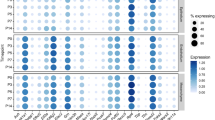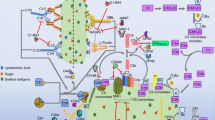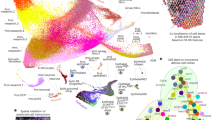Abstract
Mechanical forces are essential for normal fetal lung development. However, the cellular and molecular mechanisms regulating this process are still poorly defined. In this study, we used oligonucleotide microarrays to investigate gene expression in cultured embryonic d 19 rat fetal lung type II epithelial cells exposed to a level of mechanical strain similar to the developing lung. Significance Analysis of Microarrays (SAM) identified 92 genes differentially expressed by strain. Interestingly, several members of the solute carrier family of amino acid transporter (Slc7a1, Slc7a3, Slc6a9, and tumor-associated protein 1) genes involved in amino acid synthesis (Phgdh, Psat1, Psph, Cars, and Asns), as well as the amiloride-sensitive epithelial sodium channel gene (Scnn1a) were up-regulated by the application of force. These results were confirmed by quantitative real-time PCR (qRT-PCR). Thus, this study identifies genes induced by strain that may be important for amino acid signaling pathways and protein synthesis in fetal type II cells. In addition, these data suggest that mechanical forces may contribute to facilitate lung fluid reabsorption in preparation for birth. Taken together, the present investigation provides further insights into how mechanical forces may modulate fetal lung development.
Similar content being viewed by others
Log in or create a free account to read this content
Gain free access to this article, as well as selected content from this journal and more on nature.com
or
Abbreviations
- ENaC:
-
amiloride-sensitive epithelial sodium channel
- qRT-PCR:
-
quantitative real-time PCR
- SAM:
-
Significance Analysis of Microarrays
References
Hooper SB, Wallace MJ 2004 Role of physical, endocrine and growth factors in lung development.Harding R, Pinkerton KE, Plopper CG The Lung: Development, Aging, and the Environment. Elsevier Academic Press London UK 131–148
Joe P, Wallen LD, Chapin CJ, Lee CH, Allen L, Han VK, Dobbs LG, Hawgood S, Kitterman JA 1997 Effects of mechanical factors on growth and maturation of the lung in fetal sheep. Am J Physiol 272: L95–L105
Wirtz HR, Dobbs LG 2000 The effects of mechanical forces on lung functions. Respir Physiol 119: 1–17
Liu M, Post M 2000 Invited review: mechanochemical signal transduction in the fetal lung. J Appl Physiol 89: 2078–2084
Sanchez-Esteban J, Cicchiello LA, Wang Y, Tsai SW, Williams LK, Torday JS, Rubin LP 2001 Mechanical stretch promotes alveolar epithelial type II cell differentiation. J Appl Physiol 91: 589–595
Sanchez-Esteban J, Wang Y, Filardo EJ, Rubin LP, Ingber DE 2006 Integrins β1, α6, and α3 contribute to mechanical strain-induced differentiation of fetal lung type II epithelial cells via distinct mechanisms. Am J Physiol Lung Cell Mol Physiol 290: L343–L350
Sanchez-Esteban J, Tsai SW, Sang J, Qin J, Torday JS, Rubin LP 1998 Effects of mechanical forces on lung-specific gene expression. Am J Med Sci 316: 200–204
Sanchez-Esteban J, Wang Y, Gruppuso PA, Rubin LP 2004 Mechanical stretch induces fetal type II cell differentiation via an epidermal growth factor receptor-extracellular-regulated protein kinase signaling pathway. Am J Respir Cell Mol Biol 30: 76–83
Chen BP, Li YS, Zhao Y, Chen KD, Li S, Lao J, Yuan S, Shyy JY, Chien S 2001 DNA microarray analysis of gene expression in endothelial cells in response to 24-h shear stress. Physiol Genomics 7: 55–63
Adam RM, Eaton SH, Estrada C, Nimgaonkar A, Shih SC, Smith LE, Kohane IS, Bagli D, Freeman MR 2004 Mechanical stretch is a highly selective regulator of gene expression in human bladder smooth muscle cells. Physiol Genomics 20: 36–44
dos Santos CC, Han B, Andrade CF, Bai X, Uhlig S, Hubmayr R, Tsang M, Lodyga M, Keshavjee S, Slutsky AS, Liu M 2004 DNA microarray analysis of gene expression in alveolar epithelial cells in response to TNFalpha, LPS, and cyclic stretch. Physiol Genomics 19: 331–342
Chess PR, O'Reilly MA, Toia L 2004 Macroarray analysis reveals a strain-induced oxidant response in pulmonary epithelial cells. Exp Lung Res 30: 739–753
Patrick J, Natale R, Richardson B 1978 Patterns of human fetal breathing activity at 34 to 35 weeks' gestational age. Am J Obstet Gynecol 132: 507–513
Tusher VG, Tibshirani R, Chu G 2001 Significance analysis of microarrays applied to the ionizing radiation response. Proc Natl Acad Sci U S A 98: 5116–5121
Padbury JF, Diah SK, McGonnigal B, Miller C, Fugere C, Kuzniar M, Thompson NL 2004 Transcriptional regulation of the LAT-1/CD98 light chain. Biochem Biophys Res Commun 318: 529–534
Hummler E, Barker P, Gatzy J, Beermann F, Verdumo C, Schmidt A, Boucher R, Rossier BC 1996 Early death due to defective neonatal lung liquid clearance in alpha-ENaC-deficient mice. Nat Genet 12: 325–328
Carthew RW, Rubin GM 1990 Seven in absentia, a gene required for specification of R7 cell fate in the Drosophila eye. Cell 63: 561–577
Scavo LM, Ertsey R, Chapin CJ, Allen L, Kitterman JA 1998 Apoptosis in the development of rat and human fetal lungs. Am J Respir Cell Mol Biol 18: 21–31
Christensen HN 1990 Role of amino acid transport and countertransport in nutrition and metabolism. Physiol Rev 70: 43–77
Durante W, Liao L, Reyna SV, Peyton KJ, Schafer AI 2000 Physiological cyclic stretch directs L-arginine transport and metabolism to collagen synthesis in vascular smooth muscle. FASEB J 14: 1775–1783
Gill DJ, Low BC, Grigor MR 1996 Interleukin-1 beta and tumor necrosis factor-alpha stimulate the cat-2 gene of the L-arginine transporter in cultured vascular smooth muscle cells. J Biol Chem 271: 11280–11283
Hattori Y, Kasai K, Gross SS 1999 Cationic amino acid transporter gene expression in cultured vascular smooth muscle cells and in rats. Am J Physiol 276: H2020–H2028
Young SL, Evans K, Eu JP 2002 Nitric oxide modulates branching morphogenesis in fetal rat lung explants. Am J Physiol Lung Cell Mol Physiol 282: L379–L385
Ferrara N 2001 Role of vascular endothelial growth factor in regulation of physiological angiogenesis. Am J Physiol Cell Physiol 280: C1358–C1366
Balasubramaniam V, Tang JR, Maxey A, Plopper CG, Abman SH 2003 Mild hypoxia impairs alveolarization in the endothelial nitric oxide synthase-deficient mouse. Am J Physiol Lung Cell Mol Physiol 284: L964–L971
Jakkula M, Le Cras TD, Gebb S, Hirth KP, Tuder RM, Voelkel NF, Abman SH 2000 Inhibition of angiogenesis decreases alveolarization in the developing rat lung. Am J Physiol Lung Cell Mol Physiol 279: L600–L607
Hara A, Chapin CJ, Ertsey R, Kitterman JA 2005 Changes in fetal lung distension alter expression of vascular endothelial growth factor and its isoforms in developing rat lung. Pediatr Res 58: 30–37
Mager S, Sloan J 2003 Possible role of amino acids, peptides, and sugar transporter in protein removal and innate lung defense. Eur J Pharmacol 479: 263–267
Olver RE, Walters DV, Wilson SM 2004 Developmental regulation of lung liquid transport. Annu Rev Physiol 66: 77–101
Tchepichev S, Ueda J, Canessa C, Rossier BC, O'Brodovich H 1995 Lung epithelial Na channel subunits are differentially regulated during development and by steroids. Am J Physiol 269: C805–C812
Gonzalez R, Yang YH, Griffin C, Allen L, Tigue Z, Dobbs L 2005 Freshly isolated rat alveolar type I cells, type II cells, and cultured type II cells have distinct molecular phenotypes. Am J Physiol Lung Cell Mol Physiol 288: L179–L189
Sozo F, Wallace MJ, Zahra VA, Filby CE, Hooper SB 2006 Gene expression profiling during increased fetal lung expansion identifies genes likely to regulate development of the distal airways. Physiol Genomics 24: 105–113
Acknowledgements
The authors thank Brenda Vecchio for manuscript preparation and Carl P. Simkevich, Ph.D., for help with the microarray experiments.
Author information
Authors and Affiliations
Corresponding author
Additional information
This work was supported by National Institutes of Health grants RR018728 and RR015578. J.S.-E. is a Parker B. Francis Fellow in Pulmonary Research.
Rights and permissions
About this article
Cite this article
Wang, Y., Maciejewski, B., Weissmann, G. et al. DNA Microarray Reveals Novel Genes Induced by Mechanical Forces in Fetal Lung Type II Epithelial Cells. Pediatr Res 60, 118–124 (2006). https://doi.org/10.1203/01.pdr.0000227479.73003.b5
Received:
Accepted:
Issue date:
DOI: https://doi.org/10.1203/01.pdr.0000227479.73003.b5



